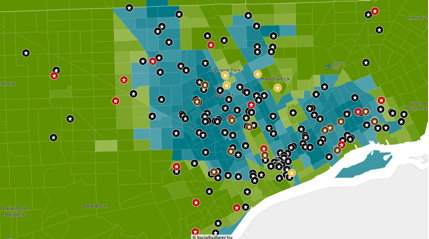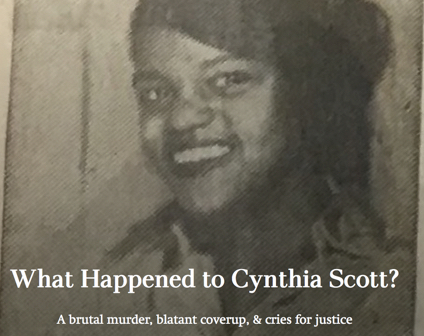
Detroit Under Fire is a multimedia digital exhibit that documents patterns and incidents of police brutality and misconduct, as well as 188 fatal shootings and other killings by law enforcement, in the city of Detroit during the era of the modern civil rights movement, from 1957-1973. The exhibit further chronicles the anti-police brutality struggle waged by civil rights and black power groups, and by many ordinary people, who demanded racial and social justice and sought accountability for systemic police violence.
The main goal of Detroit Under Fire is to uncover the deliberately hidden history of police violence, building on the work of activists at the time that these events happened, and to make this history available to impacted communities, students, and broader public audiences. The Detroit Under Fire research team has identified 75% of the officially acknowledged total of fatal shootings by police officers, and excavated more than 400 other brutality and misconduct complaints by Black citizens, from the depths of the archives. These stories are told--many for the first time publicly--in more than 100 exhibit pages that reproduce around 1,500 archival documents and allow audiences to examine these sources for themselves and dig deeper into this history.
Detroit Under Fire, published March 2021, is the pilot project of the Policing and Social Justice HistoryLab, an affiliate of the Carceral State Project at the University of Michigan. Citation: Matthew D. Lassiter and the Policing and Social Justice HistoryLab, Detroit Under Fire: Police Violence, Crime Politics, and the Struggle for Racial Justice in the Civil Rights Era (University of Michigan Carceral State Project, 2021), <specific webpage url>.
Highlights of the exhibit include:
-
The most comprehensive accounting of fatal force incidents by police officers that currently exists for any American city during the civil rights era, including evidence that two-thirds of those killed were unarmed and that at minimum 25% involved coverups of wrongful death (start at this link).
-
More than 50 interactive maps documenting the 188 identified police homicides, and more than 400 additional brutality and misconduct complaints (which are only the tip of the iceberg), interspersed throughout the exhibit and compiled in a separate map series here.
-
Detailed accounts of 47 people killed during the Detroit Uprising of 1967 (link), of all 22 fatal shootings by the notorious STRESS (Stop the Robberies, Enjoy Safe Streets) unit during the early 1970s (link), and of 84 police homicides between 1971-1973 when the Detroit Police Department was the nation's deadliest per capita (link).
-
More than 100 exhibit pages, divided into five chronological sections, that explore the policies and programs of the Detroit Police Department during this era of sweeping racial criminalization and escalating state violence, alongside the parallel mobilization and protest movements of civil rights and black power organizations that demanded protection of the constitutional rights of the city's residents and community control of the police department. (Note: the exhibit is best navigated through the top drop-down menu, which requires a laptop browser window for full functionality).
-
Reproduction of more than 1,500 archival documents, allowing viewers to explore this history for themselves, and ideal for classroom use and student research projects. For more structured appoaches than just exploring the website, visit the Multimedia Reports and Curriculum Guides pages of the Overview section, or start with the ArcGIS StoryMap series.
-
Overwhelming evidence that the Detroit Police Department was a segregationist and openly racist institution during the 1950s through the early 1970s, and that policing in the urban North was an extension rather than the opposite of the more familiar story of white supremacy and law enforcement violence in the Jim Crow South. For more, see the "Overview of the Exhibit" page and start with Section I: "Civil Rights and Police Brutality."
-
Analysis and dozens of documents from Homicide Bureau investigative files obtained through the Freedom of Information Act revealing the police department's and prosecutor's coverups of the fatal shooting of 24-year-old Cynthia Scott in 1963 (link) and the fatal shootings of teenagers Ricardo Buck and Craig Mitchell in 1971 (link), and the massive Black community protests that followed each event.
-
In-depth features on the illegal arrests and abuse of 1,500 Black males during the 1960-1961 Crash crackdown (link), the escalation of police militarization under white liberal reformers in the mid-1960s (section II), the origins of Detroit's stop-and-frisk law to facilitate racial profiling (link), the secret police campaign to destroy a black power organization by instigating the 1966 Kercheval Incident (start here), the deadly occupation of the city during the 1967 Uprising (section III), the extraordinary surge of politically motivated police violence against black power activists in the late 1960s (section IV), and the most thorough history of the infamous and deadly STRESS unit that is available anywhere (section V).
Please visit the Overview section for a summary of the major research arguments and findings, interactive maps of all police homicides, an explanation of the deliberate silences in archives of state violence, supplemental research publications that synthesize key parts of this exhibit more succinctly, and more information about this public history project and the Policing and Social Justice HistoryLab student research team. Then start exploring the five chronological sections through the top drop-down menu, on a laptop if possible (the 'previous/next' buttons at the bottom of each page make it hard to navigate the website's full scope). Readers are invited to submit additional materials and provide feedback or send other inquiries to Professor Matt Lassiter, the lead author and editor of the exhibit, at detroitunderfire@umich.edu.
Click here for front banner image credits.


